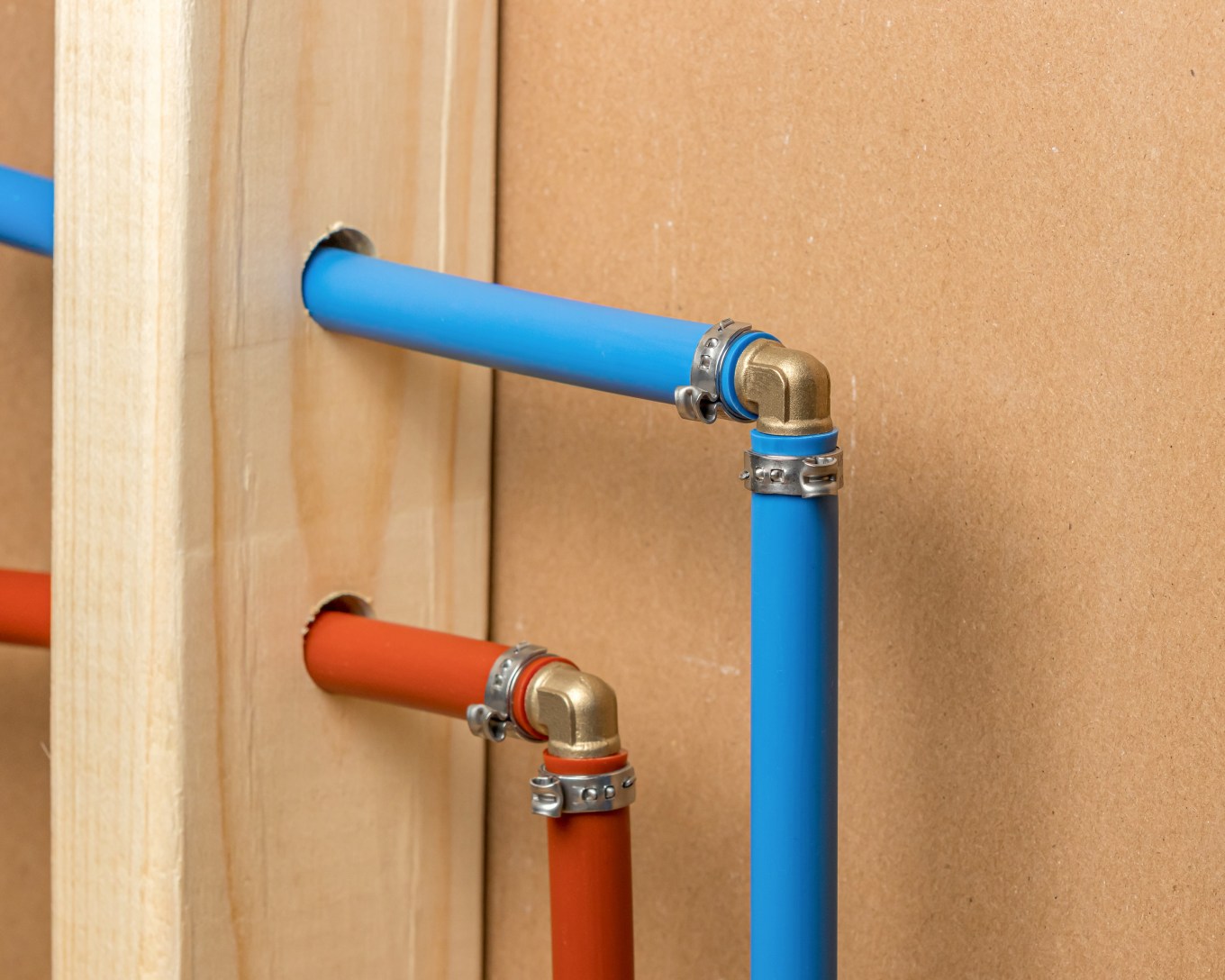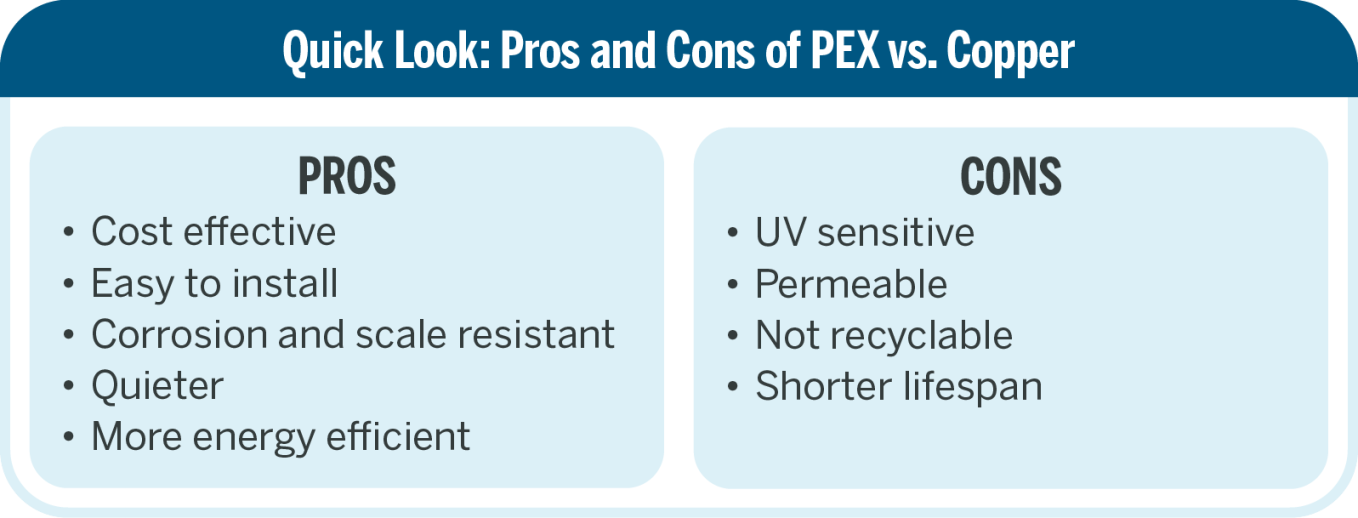If you've ever been knee-deep in a home renovation or construction project, chances are you've crossed paths with plumbing. While the thought of working on plumbing can be a DIYer's nightmare, PEX plumbing can help you get hot or cold water where and when you need it. Here’s how PEX piping works in a plumbing system and how you can easily direct the flow of water throughout your home.
What Is PEX Piping?

PEX stands for cross-linked polyethylene. It’s a flexible but durable tubing that can maintain its rigidity while being snaked through walls. That minimizes the chances of water leaking through and damaging your foundation. PEX piping is a strong replacement for other types of plumbing pipes because it doesn’t corrode, resists scale and chlorine, and can handle hot and cold water efficiently.
How PEX Plumbing Works
Imagine the water supply system in your home as a tree. The main water line is the trunk, and branches extend to every water-using fixture in your house. Because it's flexible, you can installed it in long runs without multiple fittings, clamps, elbows, or other means of redirecting water. That reduces the potential for leaks, makes caring for your plumbing system easier, and helps maintain consistent water pressure throughout your home.
How the Pros Use PEX Piping
A professional plumber working on your renovation may save you time and money by bringing PEX into the mix. Whether you can use PEX depends on your home’s water main system and the type of structure being worked on. Fitting inflexible metal pipes into pre-existing walls may be harder if you're adding to your home or renovating an area integral to the home’s foundation, the framing between walls and floors can’t support changes needed to run metal pipes through them, or insulation is creating an itchy mess.
Since the diameter of PEX piping is traditionally smaller than that of most other pipes used for plumbing, plumbers can easily drill smaller holes between floors and walls, run the PEX through them, and caulk the holes closed with less chance that a pipe might move, burst, or need replacement.
While the cost of labor for a PEX piping project might be higher upfront, you're paying for peace of mind that your plumbing won't accidentally turn your home into an indoor water park. Just be sure to look for licensed, experienced plumbers who come with credible referrals and have experience with PEX piping. Expect to pay a pro $2,000 to $4,000 to repipe a 2,000 square foot house with PEX, according to HomeGuide.
How DIYers Can Use PEX Piping
For experienced plumbing DIYers and handy homeowners, PEX may present an opportunity to tackle more small plumbing projects themselves.
The initial investment in tools, such as a basic crimping tool set, can range from modest (under $100) to substantial (several thousand dollars) depending on the quality and brand of the tool. Clamps and fittings can become costly, but as integral parts in directing water where it needs to go, you're better off not skimping on quality or quantity. That’s especially true if you don't know how much plumbing you need. If you think you may have future plumbing needs you could handle yourself, these investments could be worthwhile, though.
While PEX is easier to work with than copper or PVC piping, a lack of experience can lead to mistakes. Incorrectly installed fittings can cause leaks, and improper handling of tools or parts can damage the piping. Plus, navigating building codes and ensuring your DIY project is up to snuff can be challenging for DIYers without enough experience.
PEX plumbing FAQS
What are the advantages and disadvantages of PEX plumbing over copper pipes?

The advantages of PEX versus copper:
- Cost-effective: PEX is significantly cheaper than copper, both in terms of material cost and installation labor. PEX costs about 50 cents per square foot, while copper can cost up to $8 for the same amount, according to HomeGuide.
- Easy to install: PEX can be easily snaked through walls and requires fewer fittings and connections. That makes leaks less likely.
- Corrosion and scale resistant: Unlike copper, PEX doesn't corrode or experience mineral buildup, meaning a cleaner water supply.
- Less noisy: PEX absorbs pressure changes better than copper, reducing the chances of "water hammer" noises.
- Energy efficient: PEX offers better thermal insulation, reducing heat loss in hot water lines.
- Risk resistant: PEX is less likely to leak than copper piping is. Copper piping tends to be more prone to corrosion that can lead to leaks. PEX also resists freezing and cracking, while PVC is most likely to crack due to freezing.
The disadvantages of PEX versus copper:
- UV sensitivity: PEX can't be exposed to sunlight, because UV rays degrade the material.
- Permeability: Certain types of PEX may allow gases and contaminants to permeate. The choice depends on the quality of the piping and the environment where it’s installed.
- Not recyclable: PEX can’t be recycled, raising environmental concerns. Copper is highly recyclable.
- Shorter lifespan: Copper pipes last up to 50 years, while PEX pipe’s lifespan is shorter, between 25 and 40 years. PVC pipes, with the longest lifespan of the three, can last up to 75 years.
What are the advantages and disadvantages of PEX plumbing over PVC pipes?

The advantages of PEX versus PVC:
- Flexibility: PEX's flexibility allows for easier installation, especially in tight spaces or where pipes need to bend.
- Temperature tolerance: PEX can handle higher water temperatures than PVC, making it suitable for both hot and cold-water applications.
- Freeze resistance: PEX is more resistant to freeze-breakage than PVC.
The disadvantages of PEX over PVC:
- Cost: While cheaper than copper, PEX is generally more expensive than PVC.
- Chemical sensitivity: PEX can be more sensitive to some chemicals and solvents than PVC, which may affect its longevity in environments that have long term exposure to chemical compounds. Those environments include swimming pools and hot tubs, garages, workshops, cleaning product storage areas, or anywhere strong chemicals are used or stored.
What are the most important parts of installing PEX plumbing?
- Planning and layout: Understanding the water supply needs, mapping out the route, and ensuring compliance with local codes are all important.
- Proper tools: Having the right tools for cutting, expanding, and securing PEX connections is crucial for a successful project.
- Securing connections: Ensure that all fittings and connections are secure to prevent leaks.
- Insulation: Install PEX pipes properly in exposed areas to prevent heat loss and protect from physical damage.
- Testing: Conduct pressure testing before finalizing the installation to detect any leaks.
Why do some people not use PEX plumbing?
- Traditionalism: Some prefer the proven track record of copper or PVC.
- Local codes: Not all local building codes allow for the use of PEX plumbing.
- Environmental concerns: PEX is not recyclable, which can be a deal-breaker for eco-conscious individuals. Additionally, rodents seem attracted to the water or warmth permeating through PEX piping and may chew through it, causing leaks.
- Chemical sensitivity: Concerns about chemical leaching or gas permeation in specific environments may deter its use.
Is PEX piping bad for your health?
- General safety: PEX piping is generally considered safe for drinking water. It meets rigorous health and safety standards set by organizations such as NSF International and the ANSI/NSF 61 standard for drinking water system components.
- Quality matters: The potential for chemical leaching exists but depend largely on the quality of the PEX material and adherence to manufacturing standards. High-quality, certified PEX piping can minimize health risks.
- Water quality: Have your water quality tested if you have concerns about contamination, regardless of the piping material.
Remember, while PEX has advantages and potential drawbacks, its suitability can vary based on individual needs, local regulations, and environmental considerations. Always consult a professional and consider all factors before deciding which type of plumbing pipe is right for you.
Is PEX Plumbing the Right Choice for You?
PEX plumbing has revolutionized the way we think about plumbing in our homes. Whether you're thinking of hiring a professional plumber with years of experience or you’re a DIY enthusiast with plumbing experience, PEX offers the flexibility, durability, and efficiency that modern plumbing demands. Just remember, the key to success with PEX, as with any plumbing project, lies in understanding your skills, the scope of the project, and whether a professional plumber is your best choice.
